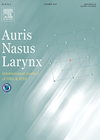
Journal Reviews archive for 2019
The debate: endoscopic vs microscopic ear surgery – meta-analysis of outcomes
Although the endoscopic approach to ear surgery has become more common in clinical practice, the debate about its role versus the traditional microscopic approach continues in many ENT units. This meta-analysis from the Mount Sinai ENT department in New York...
Is wine blocking your nose?
Salicylates are commonly found in a wide variety of foods, such as unripe fruit, vegetables, nuts, seeds and spices. They play a role in growth and development of plants, photosynthesis, transpiration, ion uptake and transport. Non-steroidal exacerbated respiratory disease (N-ERD)...
People with dementia and their families want to see speech and language therapists!
Language and communication difficulties are common in Alzheimer’s disease and, of course, language-led dementia (primary progressive aphasia). Communication difficulties are highlighted as one of the biggest burdens for family members caring for loved ones with dementia. This is often associated...
Do it like a techy: telepractice in SLT for people with Parkinson’s disease
Parkinson’s disease (PD) is the second most common neurological condition in Australia, and communication difficulties are reported by 90% of people with the condition. Unfortunately, not all people with PD have access to speech and language therapy services due to...
‘Pen’doscope - writing in a reduction in healthcare delivery costs
Optimal management of cleft lip and palate requires a multidisciplinary team approach to treatment, with the goal being maintenance of facial growth and improvement in speech and hearing, in addition to closure of the cleft. This can be especially challenging...
Outcomes of temporal bone-resurfacing for pulsatile tinnitus associated with vascular wall anomalies
This month’s Ed’s choice is an interesting systematic review into the management of pulsatile tinnitus. There are impressive results from resurfacing of symptomatic anatomical abnormalities of the temporal bone and I suspect that referrals for further imaging and otology clinic...
Outpatient solution for a Patulous tube?
Definitive diagnosis and management of Patulous Eustachian tube (PET) is unsatisfactory. Several different treatment methods are currently used for PET which itself indicates no satisfactory solution. The objective of this study was to compare the outcomes of two different treatment...
Daflon – a new way to treat idiopathic epistaxis
Epistaxis is a common ENT emergency and most cases are idiopathic. Flavonoids are natural substances with variable phenolic structures that are found in fruit and vegetables and take effect on blood vessels. Daflon is proposed to control epistaxis by “improving...
Work and the risk and carcinoma of the larynx
This is a census on the national cancer registry in France to detect professions at a higher risk of squamous cell carcinoma of the larynx. During the period 2001-2016 there were 244 registered cases of cancer of the larynx. Amongst...
Lingual tonsils and obstrucive sleep apnoea syndrome (OSAS)
Obstructive sleep apnoea can be due to narrowing of the retrolingual space by hypertrophic lingual tonsils. The authors studied 11 patients (five males and six females with a mean age of 44.3 years and a mean BMI of 28.6). All...
Which graft is better for type 1 tympanoplasty in elderly patients?
Type 1 tympanoplasty is a procedure performed to repair tympanic membrane perforations, primarily to reduce otorrhoea. This may subsequently lead to improvement of hearing. The common graft materials used are temporalis fascia and cartilage from tragus or concha. The authors...
Which cross-over frequency is best for electro-acoustic stimulation?
Advances in technology and improved soft surgical techniques have led to individuals with better hearing thresholds, especially at the low frequencies, becoming candidates for cochlear implants (CI). Surgeons are more confident that residual hearing can be preserved thus making those...
















